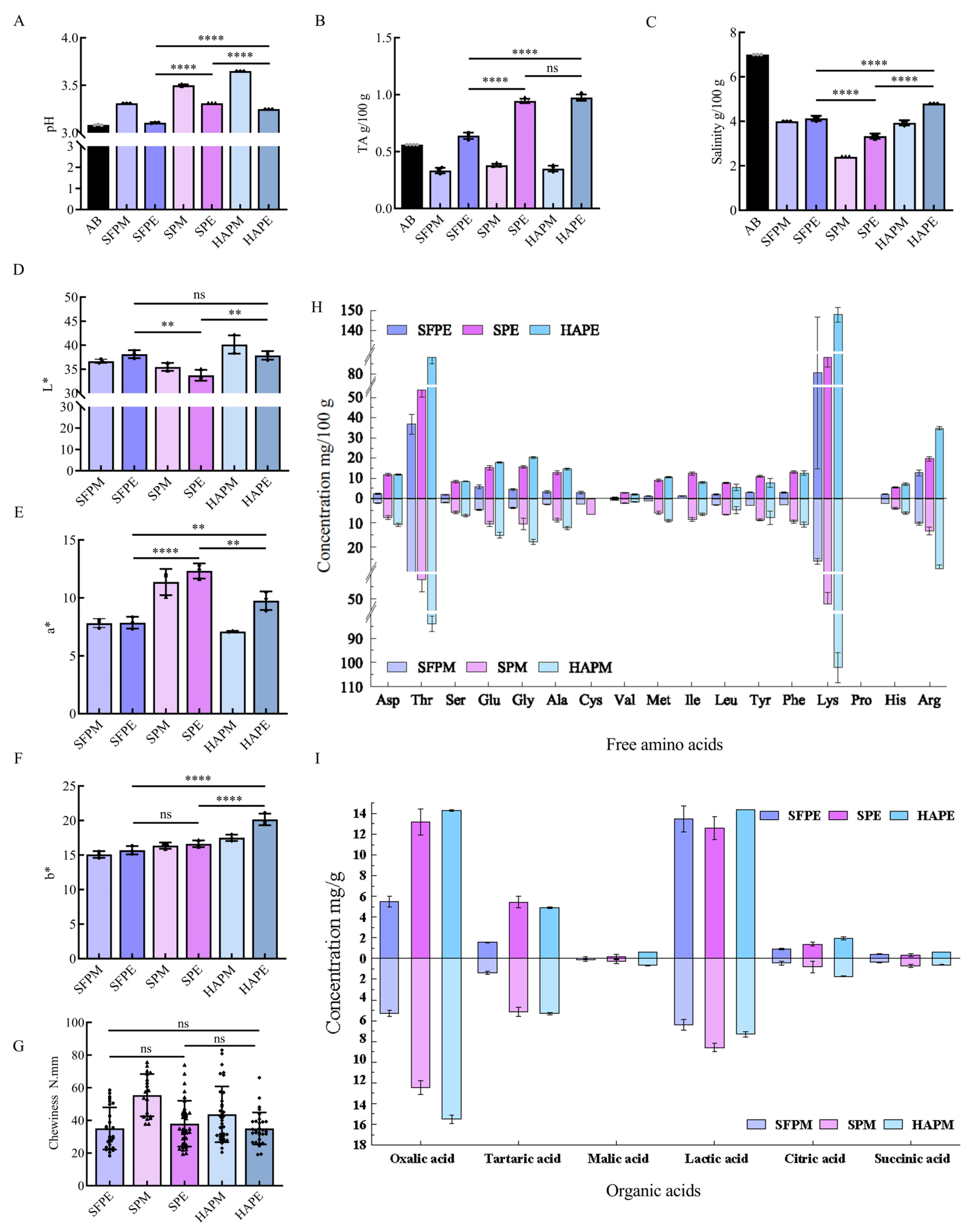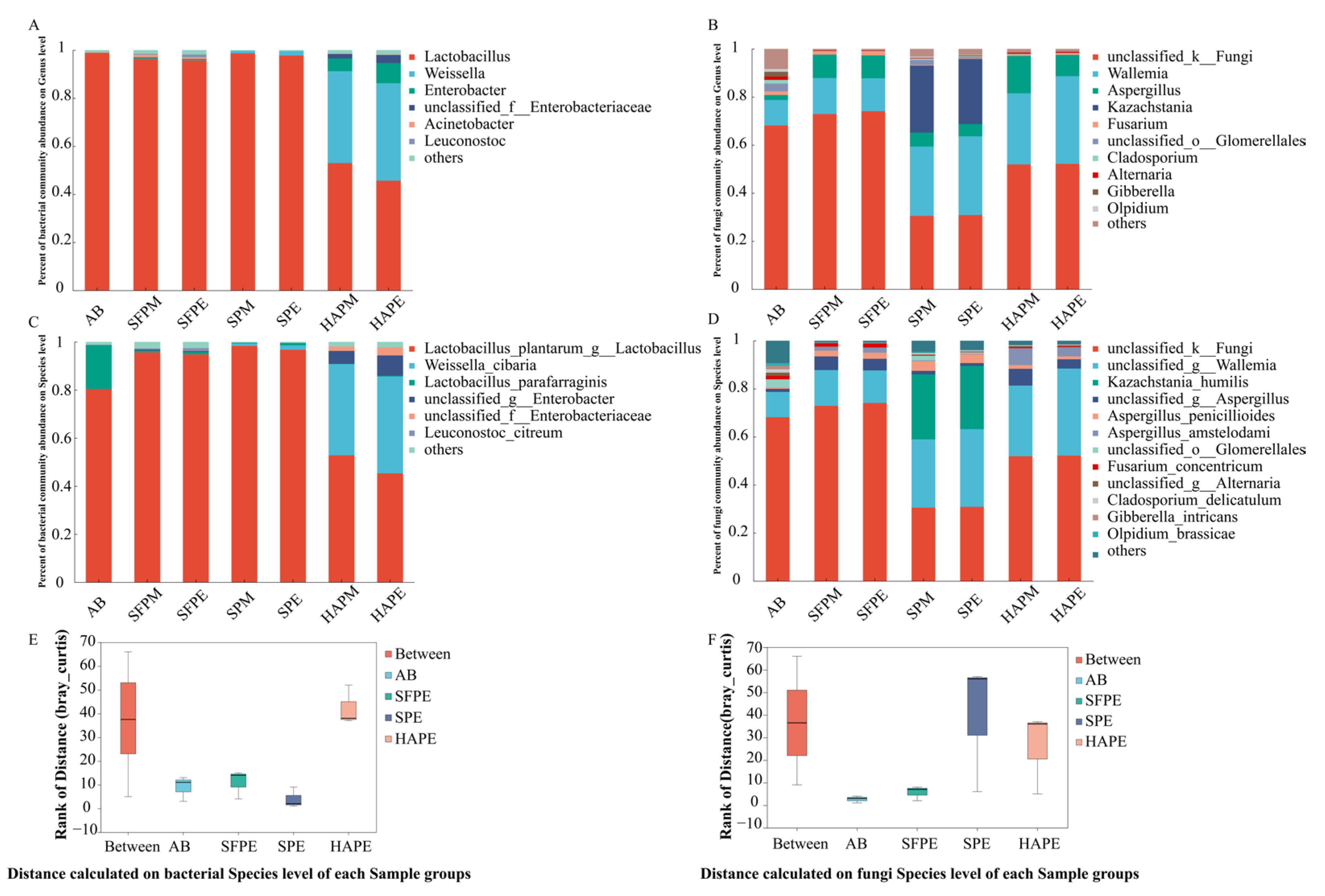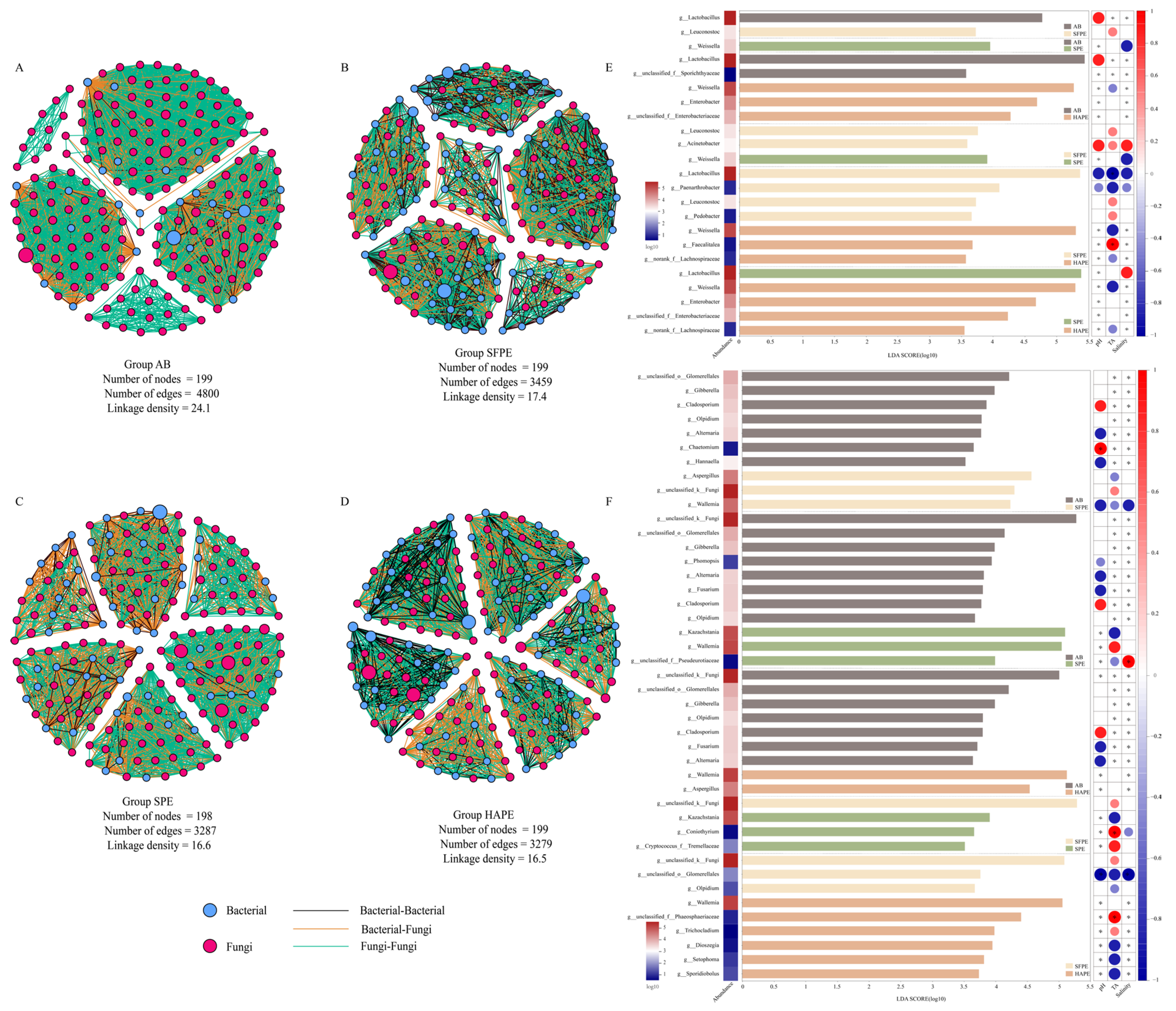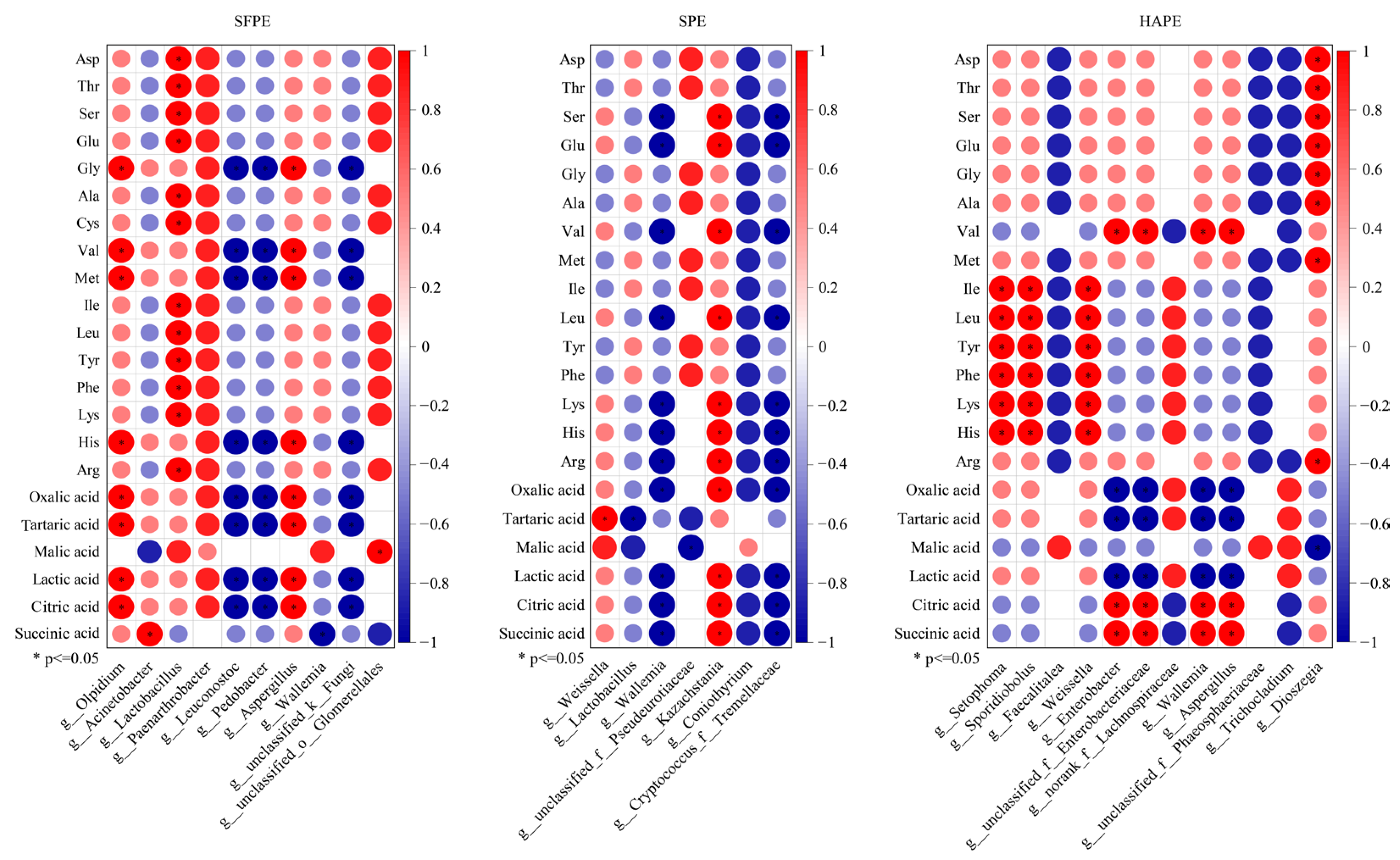Effects of Pre-Dehydration Treatments on Physicochemical Properties, Non-Volatile Flavor Characteristics, and Microbial Communities during Paocai Fermentation
Abstract
1. Introduction
2. Materials and Methods
2.1. Paocai Preparation and Sampling
2.2. Physiochemical Properties Determination
2.3. Determination of Main Non-Volatile Compounds
2.4. DNA Extraction and Sequencing of Microorganisms
2.5. Illumina Sequencing and Bioinformatics Processing
2.6. Statistical Analysis
3. Results and Discussion
3.1. Effects of Different Dehydration Pre-Treatment on the Dynamic Changes in Fermentation Parameters
3.2. Effects of Different Dehydration Pre-Treatment on Paocai Non-Volatile Flavor Compounds
3.3. Microbial Diversity and Community Structure in Paocai Fermentation with Different Dehydration Pre-Treatment
3.4. Effect of Dehydration Pre-Treatment on Microbial Community Succession in Paocai Fermentation
3.5. Effects of Abiotic Factors on Microbial Community Succession and the Shaping of Paocai Non-Volatile Flavor by Microbial Succession
4. Conclusions
Supplementary Materials
Author Contributions
Funding
Institutional Review Board Statement
Informed Consent Statement
Data Availability Statement
Acknowledgments
Conflicts of Interest
References
- Chen, A.; Luo, W.; Niu, K.; Peng, Y.; Liu, X.; Shen, G.; Zhang, Z.; Wan, H.; Luo, Q.; Li, S. Research on the relationship between sensory profile and physicochemical properties of paocai, a Chinese fermented vegetable. J. Food Process Preserv. 2019, 43, e14237. [Google Scholar] [CrossRef]
- Cai, T.; Shi, P.; Zhang, S.; Xiang, W.; Liu, J.; Lin, Z.; Tang, J. Inhibition of Perilla frutescens Essential Oil on Pellicle Formation of Candida tropicalis and Pichia kluyveri and Its Effect on Volatile Compounds in Sichuan Pickles. Foods 2023, 12, 1593. [Google Scholar] [CrossRef]
- Xiong, T.; Li, J.; Liang, F.; Wang, Y.; Guan, Q.; Xie, M. Effects of salt concentration on Chinese sauerkraut fermentation. LWT Food Sci. Technol. 2016, 69, 169–174. [Google Scholar] [CrossRef]
- Xian, S.; Zhong, H.; Yi, B.; Liu, X.; Shen, G.; Li, M.; Zhang, Z.; Luo, Q.; Li, S.; Zhou, M.; et al. Identification of pellicle formation related microorganisms in traditional Sichuan paocai through metagenomic sequence and the effects of Baijiu/Salt on pellicle and volatile components. Food Res. Int. 2022, 159, 111130. [Google Scholar] [CrossRef] [PubMed]
- Fan, Z.Y.; Deng, W.Q.; Li, X.B.; Li, H.; Chen, G.; Zhang, Q.S. Effect of air exposed storage on quality deterioration and microbial succession of traditional Sichuan Paocai. LWT Food Sci. Technol. 2022, 154, 112510. [Google Scholar] [CrossRef]
- Rao, Y.; Qian, Y.; Tao, Y.F.; She, X.; Li, Y.L.; Che, Z.M.; Li, H.H.; Liu, L. Influence of oxygen exposure on fermentation process and sensory qualities of Sichuan pickle (paocai). RSC Adv. 2019, 9, 38520–38530. [Google Scholar] [CrossRef] [PubMed]
- Tang, Y.; Chen, G.; Wang, D.; Hu, R.; Li, H.; Liu, S.; Zhang, Q.; Ming, J.; Chi, Y. Effects of dry-salting and brine-pickling processes on the physicochemical properties, nonvolatile flavour profiles and bacterial community during the fermentation of Chinese salted radishes. LWT Food Sci. Technol. 2022, 157, 113084. [Google Scholar] [CrossRef]
- Yang, J.; Li, F.; Zhang, Y.; He, Z. Metagenomic analysis of microbial community succession during the pickling process of Zhacai (preserved mustard tuber) and its correlation with Zhacai biochemical indices. J. Sci. Food Agric. 2021, 101, 1646–1658. [Google Scholar] [CrossRef] [PubMed]
- Liang, H.; Chen, H.; Zhang, W.; Yu, C.; Ji, C.; Lin, X. Investigation on microbial diversity of industrial Zhacai paocai during fermentation using high-throughput sequencing and their functional characterization. LWT Food Sci. Technol. 2018, 91, 460–466. [Google Scholar] [CrossRef]
- Jiang, L.J.; Xian, S.; Liu, X.; Shen, G.; Zhang, Z.; Hou, X.; Chen, A. Metagenomic study on chinese homemade paocai: The effects of raw materials and fermentation periods on the microbial ecology and volatile components. Foods 2022, 11, 62. [Google Scholar] [CrossRef]
- Qiu, L.Q.; Zhang, M.; Wang, Y.C.; Liu, Y.P. Physicochemical and nutritional properties of wasabi (Eutrema yunnanense) dried by four different drying methods. Dry. Technol. 2019, 37, 363–372. [Google Scholar] [CrossRef]
- Luo, Z.C.; Zhou, L.G.; Zhu, Y.W.; Zhou, C.Q. Effects of different drying methods on the physicochemical property and edible quality of fermentedPyracantha fortuneanafruit powder. Int. J. Food Sci. Technol. 2021, 56, 773–784. [Google Scholar] [CrossRef]
- Lin, L.-J.; Zeng, J.; Tian, Q.-M.; Ding, X.-Q.; Zhang, X.-Y.; Gao, X.-Y. Effect of the bacterial community on the volatile flavour profile of a Chinese fermented condiment-Red sour soup-During fermentation. Food Res. Int. 2022, 155, 111059. [Google Scholar] [CrossRef]
- Zhao, Y.; Wu, Z.; Miyao, S.; Zhang, W. Unraveling the flavor profile and microbial roles during industrial Sichuan radish paocai fermentation by molecular sensory science and metatranscriptomics. Food Biosci. 2022, 48, 101815. [Google Scholar] [CrossRef]
- Xian, S.; Li, Y.; Liu, X.; Shen, G.; Zhou, M.; Li, M.; Hou, X.; Li, S.; Luo, Q.; Zhang, Z.; et al. Impact of microorganisms on key processes of organic acid metabolism during the occurrence and disappearance of paocai pellicle. J. Food Sci. 2024, 89, 5047–5064. [Google Scholar] [CrossRef]
- GB12456-2021; Code of National food Safety Standard of China. Determination of Titratable Acidity in Foods. National Health Commission of the People’s Republic of China, State Administration for Market Regulation: Beijing, China, 2017.
- Chen, A.; Luo, W.; Peng, Y.; Niu, K.; Liu, X.; Shen, G.; Zhang, Z.; Wan, H.; Luo, Q.; Li, S. Quality and microbial flora changes of radish paocai during multiple fermentation rounds. Food Control 2019, 106, 106733. [Google Scholar] [CrossRef]
- Zhou, M.; Zheng, X.; Zhu, H.; Li, L.; Zhang, L.; Liu, M.; Liu, Z.; Peng, M.; Wang, C.; Li, Q.; et al. Effect of Lactobacillus plantarum enriched with organic/inorganic selenium on the quality and microbial communities of fermented pickles. Food Chem. 2021, 365, 130495. [Google Scholar] [CrossRef]
- Yang, Y.; Fan, Y.; Li, T.; Yang, Y.; Zeng, F.; Wang, H.; Suo, H.; Song, J.; Zhang, Y. Microbial composition and correlation between microbiota and quality-related physiochemical characteristics in chongqing radish paocai. Food Chem. 2022, 369, 130897. [Google Scholar] [CrossRef]
- Thierry, A.; Baty, C.; Marché, L.; Chuat, V.; Picard, O.; Lortal, S.; Valence, F. Lactofermentation of vegetables: An ancient method of preservation matching new trends. Trends Food Sci. Technol. 2023, 139, 104112. [Google Scholar] [CrossRef]
- Paredes, J.; Cortizo-Lacalle, D.; Imaz, A.M.; Aldazabal, J.; Vila, M. Application of texture analysis methods for the characterization of cultured meat. Sci. Rep. 2022, 12, 3898. [Google Scholar] [CrossRef]
- Yang, Z.; Luo, F.; Zhong, K.; Huang, C.; Yu, Z.; Peng, Z.; Wu, Y.; Bu, Q.; Gao, H. Effect of Bacillus subtilis Y61 inoculation on bacterial community and metabolic profile of sichuan paocai fermentation. Lwt Food Sci. Technol. 2021, 137, 3898. [Google Scholar] [CrossRef]
- Wu, R.; Yu, M.; Liu, X.; Meng, L.; Wang, Q.; Xue, Y.; Wu, J.; Yue, X. Changes in flavour and microbial diversity during natural fermentation of suan-cai, a traditional food made in Northeast China. Int. J. Food Microbiol. 2015, 211, 23–31. [Google Scholar] [CrossRef] [PubMed]
- Zhao, G.Q.; Zhang, Y.; Hoon, M.A.; Chandrashekar, J.; Erlenbach, I.; Ryba, N.J.P.; Zuker, C.S. The Receptors for Mammalian Sweet and Umami Taste. Cell 2003, 115, 255–266. [Google Scholar] [CrossRef] [PubMed]
- Nelson, G.; Chandrashekar, J.; Hoon, M.A.; Feng, L.; Zhao, G.; Ryba, N.J.P.; Zuker, C.S. An amino-acid taste receptor. Nature 2002, 416, 199–202. [Google Scholar] [CrossRef]
- Xie, C.; Zeng, H.; Li, J.; Qin, L. Comprehensive explorations of nutritional, functional and potential tasty components of various types of Sufu, a Chinese fermented soybean appetizer. Food Sci. Technol. 2019, 39, 105–114. [Google Scholar] [CrossRef]
- Xiao, M.; Peng, Z.; Hardie, W.J.; Huang, T.; Liu, Z.; Zhang, Y.; Xie, M.; Xiong, T. Exploring the typical flavours formation by combined with metatranscriptomics and metabolomics during Chinese Sichuan paocai fermentation. LWT Food Sci. Technol. 2022, 153, 112474. [Google Scholar] [CrossRef]
- Shang, Z.; Ye, Z.; Li, M.; Ren, H.; Cai, S.; Hu, X.; Yi, J. Dynamics of microbial communities, flavor, and physicochemical properties of pickled chayote during an industrial-scale natural fermentation: Correlation between microorganisms and metabolites. Food Chem. 2022, 377, 132004. [Google Scholar] [CrossRef] [PubMed]
- Xiao, Y.; Huang, T.; Xu, Y.; Peng, Z.; Liu, Z.; Guan, Q.; Xie, M.; Xiong, T. Metatranscriptomics reveals the gene functions and metabolic properties of the major microbial community during Chinese Sichuan Paocai fermentation. Food Microbiol. 2021, 98, 103573. [Google Scholar] [CrossRef]
- Mi, T.; Wang, D.; Yao, S.; Yang, H.; Che, Y.; Wu, C. Effects of salt concentration on the quality and microbial diversity of spontaneously fermented radish paocai. Food Res. Int. 2022, 160, 111622. [Google Scholar] [CrossRef]
- Lima-Mendez, G.; Faust, K.; Henry, N.; Decelle, J.; Colin, S.; Carcillo, F.; Chaffron, S.; Ignacio-Espinosa, J.C.; Roux, S.; Vincent, F.; et al. Determinants of community structure in the global plankton interactome. Science 2015, 348, 1262073. [Google Scholar] [CrossRef]
- Goberna, M.; Montesinos-Navarro, A.; Valiente-Banuet, A.; Colin, Y.; Gomez-Fernandez, A.; Donat, S.; Navarro-Cano, J.A.; Verdu, M. Incorporating phylogenetic metrics to microbial co-occurrence networks based on amplicon sequences to discern community assembly processes. Mol. Ecol. Resour. 2019, 19, 1552–1564. [Google Scholar] [CrossRef] [PubMed]
- Barner, A.K.; Coblentz, K.E.; Hacker, S.D.; Menge, B.A. Fundamental contradictions among observational and experimental estimates of non-trophic species interactions. Ecology 2018, 99, 557–566. [Google Scholar] [CrossRef] [PubMed]
- Yuan, M.M.; Guo, X.; Wu, L.; Zhang, Y.; Xiao, N.; Ning, D.; Shi, Z.; Zhou, X.; Wu, L.; Yang, Y.; et al. Climate warming enhances microbial network complexity and stability. Nat. Clim. Chang. 2021, 11, 343–348. [Google Scholar] [CrossRef]
- Chen, E.Z.; Li, H.Z. A two-part mixed-effects model for analyzing longitudinal microbiome compositional data. Bioinformatics 2016, 32, 2611–2617. [Google Scholar] [CrossRef]
- Li, C.; Jin, L.; Zhang, C.; Li, S.; Zhou, T.; Hua, Z.; Wang, L.; Ji, S.; Wang, Y.; Gan, Y.; et al. Destabilized microbial networks with distinct performances of abundant and rare biospheres in maintaining networks under increasing salinity stress. iMeta 2023, 2, e79. [Google Scholar] [CrossRef]
- Chen, W.; Wang, J.; Chen, X.; Meng, Z.; Xu, R.; Duoji, D.; Zhang, J.; He, J.; Wang, Z.; Chen, J.; et al. Soil microbial network complexity predicts ecosystem function along elevation gradients on the Tibetan Plateau. Soil Biol. Biochem. 2022, 172, 108766. [Google Scholar] [CrossRef]
- Wagg, C.; Schlaeppi, K.; Banerjee, S.; Kuramae, E.E.; van der Heijden, M.G.A. Fungal-bacterial diversity and microbiome complexity predict ecosystem functioning. Nat. Commun. 2019, 10, 4841. [Google Scholar] [CrossRef] [PubMed]
- Montoya, J.M.; Pimm, S.L.; Solé, R.V. Ecological networks and their fragility. Nature 2006, 442, 259–264. [Google Scholar] [CrossRef] [PubMed]
- Hernandez, D.J.; David, A.S.; Menges, E.S.; Searcy, C.A.; Afkhami, M.E. Environmental stress destabilizes microbial networks. ISME J. 2021, 15, 1722–1734. [Google Scholar] [CrossRef]
- Stouffer, D.B.; Bascompte, J. Compartmentalization increases food-web persistence. Proc. Natl. Acad. Sci. USA 2011, 108, 3648–3652. [Google Scholar] [CrossRef]
- Segata, N.; Izard, J.; Waldron, L.; Gevers, D.; Miropolsky, L.; Garrett, W.S.; Huttenhower, C. Metagenomic biomarker discovery and explanation. Genome Biol. 2011, 12, R60. [Google Scholar] [CrossRef] [PubMed]
- Wang, D.; Chen, G.; Tang, Y.; Ming, J.; Huang, R.; Li, J.; Ye, M.; Fan, Z.; Chi, Y.; Zhang, Q.; et al. Study of bacterial community succession and reconstruction of the core lactic acid bacteria to enhance the flavor of paocai. Int. J. Food Microbiol. 2022, 375, 109702. [Google Scholar] [CrossRef] [PubMed]
- Yu, Y.; Xu, Y.; Li, L.; Yu, Y.; Xu, Z. Dynamic evolution of flavor substances and bacterial communities during fermentation of leaf mustard (Brassica juncea var. multiceps) and their correlation. LWT Food Sci. Technol. 2022, 167, 113796. [Google Scholar] [CrossRef]
- Yan, P.; Jia, J.; Zhao, H.; Wu, C. Changes and Driving Mechanism of Microbial Community Structure during Paocai Fermentation. Fermentation 2022, 8, 281. [Google Scholar] [CrossRef]
- Dong, W.; Shen, H.; Liu, H.; Song, F.; Li, P.; Peng, N.; Liang, Y.; Zhao, S. Unraveling the microbial community and succession during zha-chili fermentation and their relationships with flavor formation. Food Res. Int. 2022, 157, 111239. [Google Scholar] [CrossRef]
- Du, Y.-K.; Xin, W.; Xia, Y.; Zhu, M.; Qin, J.-L.; Pan, Z.-F.; Wu, R.-F.; Luo, G.-R.; Wu, P.-S.; Wu, Z.-Y.; et al. Analysis of fermentation control factors on volatile compounds of primary microorganisms in Jiang-flavor Daqu. J. Food Biochem. 2022, 46, e14277. [Google Scholar] [CrossRef]
- de Araújo, J.A.; Ferreira, N.R.; da Silva, S.H.M.; Oliveira, G.; Monteiro, R.C.; Alves, Y.F.M.; Lopes, A.S. Filamentous fungi diversity in the natural fermentation of Amazonian cocoa beans and the microbial enzyme activities. Ann. Microbiol. 2019, 69, 975–987. [Google Scholar] [CrossRef]
- Ye, Z.; Shang, Z.; Zhang, S.; Li, M.; Zhang, X.; Ren, H.; Hu, X.; Yi, J. Dynamic analysis of flavor properties and microbial communities in Chinese pickled chili pepper (Capsicum frutescens L.): A typical industrial-scale natural fermentation process. Food Res. Int. 2022, 153, 110952. [Google Scholar] [CrossRef] [PubMed]
- Zajc, J.; Gunde-Cimerman, N. The Genus Wallemia—From Contamination of Food to Health Threat. Microorganisms 2018, 6, 46. [Google Scholar] [CrossRef]
- Franco, W.; Perez-Diaz, I.M. Development of a model system for the study of spoilage associated secondary cucumber fermentation during long-term storage. J. Food Sci. 2012, 77, 586–592. [Google Scholar] [CrossRef]
- Xu, X.; Wu, B.; Zhao, W.; Lao, F.; Chen, F.; Liao, X.; Wu, J. Shifts in autochthonous microbial diversity and volatile metabolites during the fermentation of chili pepper (Capsicum frutescens L.). Food Chem. 2021, 335, 127512. [Google Scholar] [CrossRef] [PubMed]
- Wang, X.; Song, G.; He, Z.; Zhao, M.; Cao, X.; Lin, X.; Ji, C.; Zhang, S.; Liang, H. Effects of salt concentration on the quality of paocai, a fermented vegetable product from China. J. Sci. Food Agric. 2021, 101, 6202–6210. [Google Scholar] [CrossRef] [PubMed]
- Song, Q.; Zhao, F.; Wang, B.; Han, Y.; Zhou, Z. Metagenomic insights into Chinese northeast suancai: Predominance and diversity of genes associated with nitrogen metabolism in traditional household suancai fermentation. Food Res. Int. 2021, 139, 109924. [Google Scholar] [CrossRef] [PubMed]
- Zhang, C.; Zhang, J.; Liu, D. Biochemical changes and microbial community dynamics during spontaneous fermentation of Zhacai, a traditional pickled mustard tuber from China. Int. J. Food Microbiol. 2021, 347, 109199. [Google Scholar] [CrossRef]
- Xiao, Y.S.; Xiong, T.; Peng, Z.; Liu, C.G.; Huang, T.; Yu, H.; Xie, M.Y. Correlation between microbiota and flavours in fermentation of Chinese Sichuan Paocai. Food Res. Int. 2018, 114, 123–132. [Google Scholar] [CrossRef]
- Lin, L.-J.; Du, F.-M.; Zeng, J.; Liang, Z.-J.; Zhang, X.-Y.; Gao, X.-Y. Deep insights into fungal diversity in traditional Chinese sour soup by Illumina MiSeq sequencing. Food Res. Int. 2020, 137, 109439. [Google Scholar] [CrossRef]
- Cai, H.; Dumba, T.; Sheng, Y.; Li, J.; Lu, Q.; Liu, C.; Cai, C.; Feng, F.; Zhao, M. Microbial diversity and chemical property analyses of sufu products with different producing regions and dressing flavors. LWT Food Sci. Technol. 2021, 144, 111245. [Google Scholar] [CrossRef]





| Free Amino Acids Content mg/100 g | SFPM | SFPE | SPM | SPE | HAPM | HAPE |
|---|---|---|---|---|---|---|
| Aspartic acid | 1.7974 ± 0.0971 a | 2.2433 ± 0.2869 a | 7.7187 ± 0.7760 b | 11.8045 ± 0.7073 d | 10.7665 ± 0.6574 c | 11.7254 ± 0.2920 d |
| Threonine | 37.4293 ± 1.8903 a | 36.8461 ± 4.958 a | 42.0673 ± 5.0483 a | 53.6363 ± 3.4543 b | 84.0638 ± 3.3210 c | 88.1927 ± 3.0909 c |
| Serine | 1.5373 ± 0.0967 a | 1.7929 ± 0.2516 a | 5.6981 ± 0.5005 b | 8.2889 ± 0.4772 d | 7.0426 ± 0.4416 c | 8.3944 ± 0.1971 d |
| Glutamic acid | 4.7133 ± 0.2998 a | 5.6375 ± 0.8928 a | 10.4687 ± 0.9571 b | 15.1218 ± 1.0232 c | 15.1037 ± 1.1402 c | 17.7055 ± 0.3553 d |
| Glycine | 3.8601 ± 0.2230 a | 4.2904 ± 0.5292 a | 10.3854 ± 2.2871 b | 15.5848 ± 0.6441 c | 17.7817 ± 1.0344 d | 20.2282 ± 0.5421 e |
| Alanine | 2.3432 ± 0.1093 a | 3.1295 ± 0.5345 a | 8.8045 ± 0.7557 b | 12.7327 ± 0.9390 c | 12.1374 ± 0.6966 c | 14.5047 ± 0.4127 d |
| Cysteine | 2.1933 ± 0.0143 a | 2.9216 ± 0.5896 a | 6.4672 ± 0 b | 0 ± 0 | 0 ± 0 | 0 ± 0 |
| Valine | 0.519 ± 0.0473 a | 0.4599 ± 0.2843 a | 1.9032 ± 0.1733 b | 2.7813 ± 0.0906 c | 1.4216 ± 0.0768 d | 1.8908 ± 0.2329 b |
| Methionine | 0.8985 ± 0.0674 a | 1.0546 ± 0.1230 a | 5.8930 ± 0.6577 b | 8.9479 ± 0.6365 c | 9.034 ± 0.5251 c | 10.4857 ± 0.2535 d |
| Isoleucine | 0 ± 0 a | 1.2421 ± 0.1376 b | 8.5374 ± 0.7204 c | 12.3552 ± 0.7935 d | 6.5441 ± 0.5095 s e | 7.9352 ± 0.4453 c |
| Leucine | 2.6208 ± 0.0605 a | 2.0238 ± 0.3190 a | 6.5453 ± 0.1597 bc | 7.7458 ± 0.3024 c | 4.7393 ± 1.4020 d | 5.4626 ± 1.6359 bd |
| Tyrosine | 2.8118 ± 0.0488 a | 3.0584 ± 0.1598 a | 8.7597 ± 0.3993 bc | 10.9348 ± 0.3807 b | 7.8992 ± 2.7545 c | 7.7378 ± 2.215 c |
| Phenylalanine | 2.5352 ± 0.0599 a | 2.8929 ± 0.2877 a | 9.5100 ± 0.7473 b | 12.9370 ± 0.7061 c | 10.8038 ± 1.0806 b | 12.4509 ± 1.1332 c |
| Lysine | 25.8776 ± 1.1195 a | 80.6010 ± 66.0833 b | 52.2169 ± 4.8622 ab | 88.2644 + 4.7477 b | 102.1497 ± 6.2020 bc | 147.8372 ± 3.5808 c |
| Proline | 0 ± 0 | 0 ± 0 | 0 ± 0 | 0 ± 0 | 0 ± 0 | 0 ± 0 |
| Histidine | 1.8190 ± 0.0086 a | 1.9820 ± 0.1775 a | 4.0239 ± 0.4627 b | 5.4058 ± 0.3099 c | 5.9936 ± 0.5822 c | 6.9673 ± 0.5633 d |
| Arginine | 10.2704 ± 0.5672 a | 12.6055 ± 1.5400 ab | 13.2855 ± 1.6007 b | 19.6208 ± 1.2635 c | 28.9423 ± 1.6849 d | 34.7483 ± 0.9182 e |
| TAA | 101.2262 ± 4.2953 a | 162.7814 ± 73.4453 b | 197.9734 ± 16.4294 b | 286.1596 ± 16.3037 c | 324.4233 ± 15.7344 c | 396.2666 ± 12.0319 d |
| EAA | 69.8804 ± 2.9771 a | 125.1203 ± 70.0470 b | 126.6731 ± 12.3120 b | 186.6657 ± 10.5866 c | 218.7564 ± 10.3222 c | 274.2551 ± 8.0948 d |
| NEAA | 19.2565 ± 0.7752 a | 23.0737 ± 2.8497 a | 53.9909 ± 2.2318 b | 74.4674 ± 4.1557 c | 70.7311 ± 3.7673 c | 80.2960 ± 2.6973 d |
| Umami Amino Acid | 6.5107 ± 0.3922 a | 7.8808 ± 1.1778 a | 18.1874 ± 1.7319 b | 26.9263 ± 1.7230 c | 25.8702 ± 1.7976 c | 29.4309 ± 0.6453 d |
| Umami Amino Acid/TAA | 0.0643 ± 0.0015 a | 0.0527 ± 0.0146 a | 0.0918 ± 0.0012 b | 0.0941 ± 0.0008 c | 0.0797 ± 0.0027 c | 0.0743 ± 0.0012 d |
| Sweet amino acid | 45.17 ± 2.2832 a | 46.0589 ± 6.0387 a | 66.9553 ± 8.5781 b | 90.2426 ± 5.4785 c | 121.0255 ± 5.4883 d | 131.32 ± 4.2378 e |
| Sweet amino acid/TAA | 0.4461 ± 0.0066 a | 0.3104 ± 0.093 a | 0.3374 ± 0.0172 b | 0.3153 ± 0.003 c | 0.3731 ± 0.0066 d | 0.3315 ± 0.0091 e |
| Bitter amino acid | 46.8332 ± 1.7400 a | 105.4602 ± 67.8656 b | 108.7718 ± 9.5729 b | 166.2094 ± 9.1038 c | 176.1060 ± 9.4077 c | 233.6250 ± 9.5474 d |
| Bitter amino acid/TAA | 0.4628 ± 0.0057 a | 0.6146 ± 0.1128 b | 0.5493 ± 0.0029 b | 0.5809 ± 0.0026 c | 0.5428 ± 0.0085 c | 0.5895 ± 0.0107 d |
| EAA/NEAA | 2.2293 ± 0.0065 ab | 3.2420 ± 1.5288 a | 1.7741 ± 0.0774 b | 1.8762 ± 0.0072 b | 2.0707 ± 0.0267 ab | 2.2479 ± 0.0080 ab |
| EAA/TAA | 0.6903 ± 0.0006 ab | 0.7460 ± 0.0758 b | 0.6393 ± 0.0102 a | 0.6523 ± 0.0009 a | 0.6743 ± 0.0029 a | 0.1053 ± 0.0008 ab |
Disclaimer/Publisher’s Note: The statements, opinions and data contained in all publications are solely those of the individual author(s) and contributor(s) and not of MDPI and/or the editor(s). MDPI and/or the editor(s) disclaim responsibility for any injury to people or property resulting from any ideas, methods, instructions or products referred to in the content. |
© 2024 by the authors. Licensee MDPI, Basel, Switzerland. This article is an open access article distributed under the terms and conditions of the Creative Commons Attribution (CC BY) license (https://creativecommons.org/licenses/by/4.0/).
Share and Cite
Xian, S.; Zhao, F.; Huang, X.; Liu, X.; Zhang, Z.; Zhou, M.; Shen, G.; Li, M.; Chen, A. Effects of Pre-Dehydration Treatments on Physicochemical Properties, Non-Volatile Flavor Characteristics, and Microbial Communities during Paocai Fermentation. Foods 2024, 13, 2852. https://doi.org/10.3390/foods13172852
Xian S, Zhao F, Huang X, Liu X, Zhang Z, Zhou M, Shen G, Li M, Chen A. Effects of Pre-Dehydration Treatments on Physicochemical Properties, Non-Volatile Flavor Characteristics, and Microbial Communities during Paocai Fermentation. Foods. 2024; 13(17):2852. https://doi.org/10.3390/foods13172852
Chicago/Turabian StyleXian, Shuang, Feng Zhao, Xinyan Huang, Xingyan Liu, Zhiqing Zhang, Man Zhou, Guanghui Shen, Meiliang Li, and Anjun Chen. 2024. "Effects of Pre-Dehydration Treatments on Physicochemical Properties, Non-Volatile Flavor Characteristics, and Microbial Communities during Paocai Fermentation" Foods 13, no. 17: 2852. https://doi.org/10.3390/foods13172852
APA StyleXian, S., Zhao, F., Huang, X., Liu, X., Zhang, Z., Zhou, M., Shen, G., Li, M., & Chen, A. (2024). Effects of Pre-Dehydration Treatments on Physicochemical Properties, Non-Volatile Flavor Characteristics, and Microbial Communities during Paocai Fermentation. Foods, 13(17), 2852. https://doi.org/10.3390/foods13172852








